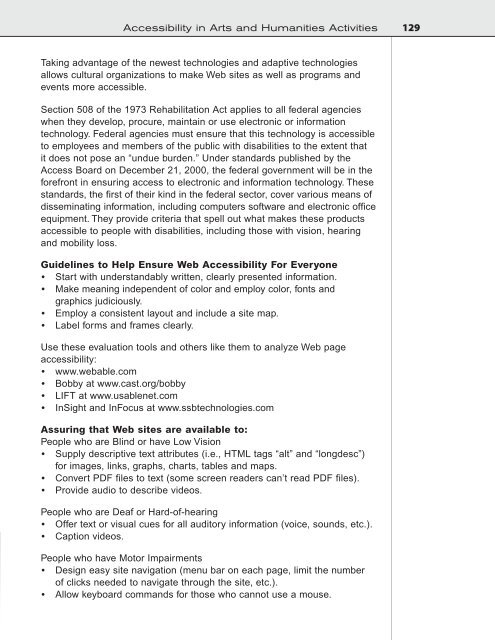Design for Accessibility: A Cultural Administrator's Handbook
Design for Accessibility: A Cultural Administrator's Handbook
Design for Accessibility: A Cultural Administrator's Handbook
You also want an ePaper? Increase the reach of your titles
YUMPU automatically turns print PDFs into web optimized ePapers that Google loves.
<strong>Accessibility</strong> in Arts and Humanities Activities 129<br />
Taking advantage of the newest technologies and adaptive technologies<br />
allows cultural organizations to make Web sites as well as programs and<br />
events more accessible.<br />
Section 508 of the 1973 Rehabilitation Act applies to all federal agencies<br />
when they develop, procure, maintain or use electronic or in<strong>for</strong>mation<br />
technology. Federal agencies must ensure that this technology is accessible<br />
to employees and members of the public with disabilities to the extent that<br />
it does not pose an “undue burden.” Under standards published by the<br />
Access Board on December 21, 2000, the federal government will be in the<br />
<strong>for</strong>efront in ensuring access to electronic and in<strong>for</strong>mation technology. These<br />
standards, the first of their kind in the federal sector, cover various means of<br />
disseminating in<strong>for</strong>mation, including computers software and electronic office<br />
equipment. They provide criteria that spell out what makes these products<br />
accessible to people with disabilities, including those with vision, hearing<br />
and mobility loss.<br />
Guidelines to Help Ensure Web <strong>Accessibility</strong> For Everyone<br />
• Start with understandably written, clearly presented in<strong>for</strong>mation.<br />
• Make meaning independent of color and employ color, fonts and<br />
graphics judiciously.<br />
• Employ a consistent layout and include a site map.<br />
• Label <strong>for</strong>ms and frames clearly.<br />
Use these evaluation tools and others like them to analyze Web page<br />
accessibility:<br />
• www.webable.com<br />
• Bobby at www.cast.org/bobby<br />
• LIFT at www.usablenet.com<br />
• InSight and InFocus at www.ssbtechnologies.com<br />
Assuring that Web sites are available to:<br />
People who are Blind or have Low Vision<br />
• Supply descriptive text attributes (i.e., HTML tags “alt” and “longdesc”)<br />
<strong>for</strong> images, links, graphs, charts, tables and maps.<br />
• Convert PDF files to text (some screen readers can’t read PDF files).<br />
• Provide audio to describe videos.<br />
People who are Deaf or Hard-of-hearing<br />
• Offer text or visual cues <strong>for</strong> all auditory in<strong>for</strong>mation (voice, sounds, etc.).<br />
• Caption videos.<br />
People who have Motor Impairments<br />
• <strong>Design</strong> easy site navigation (menu bar on each page, limit the number<br />
of clicks needed to navigate through the site, etc.).<br />
• Allow keyboard commands <strong>for</strong> those who cannot use a mouse.


